
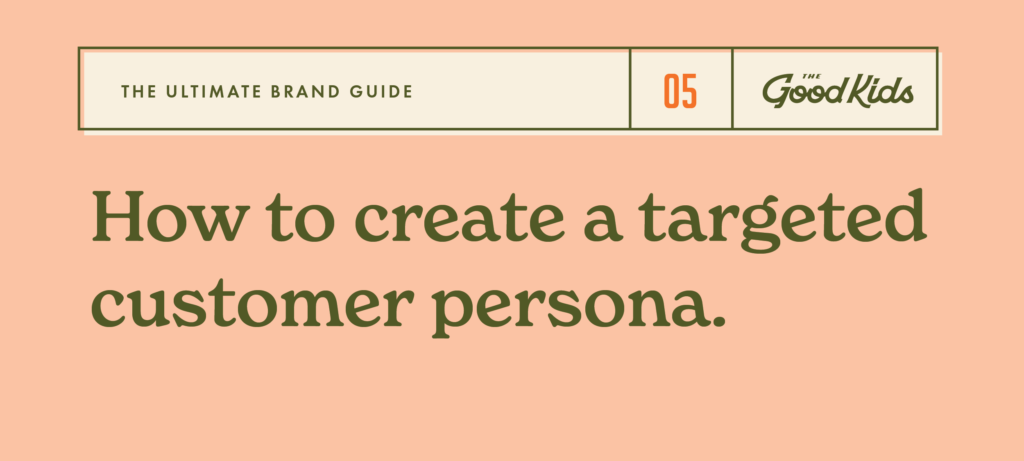
Now that we’ve spent a few weeks doing the deep, inner work behind who your business is, what you stand for, and where you’re going, it’s time to flip the script and talk about the true hero, your customer.
You see, everyone wants to be the hero of their own story, so when it comes to reaching your audience, instead of focusing on you, the product, and all its amazing features, it’s more effective to talk about your specific customer and how you can help them reach their goals.
How will you make them be the best they can be?
For example, if your ideal client is James Bond, then you have to be Q (or maybe just really good at making martinis).
The point is, if you can clearly identify who your ideal customer is and how to help them using customer personas, the results will lead to your customers believing, “I couldn’t have done it without [insert your name here]” and that’s where good branding and increased revenue is born.
A customer persona (also known as a buyer or marketing persona) is a semi-fictional person that represents the key traits of your ideal customer (the ones you absolutely love working for), based on data you’ve collected from research and analytics.
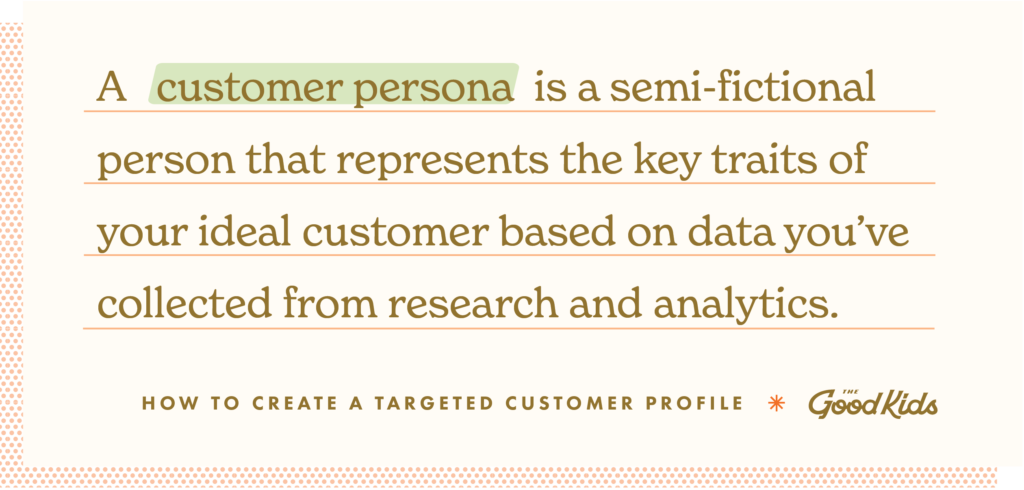
Why are target personas effective?
Now you might be thinking, “Everyone is our customer so what’s the point?”
While you might attract a lot of different kinds of people right now, I bet if you do a little research and consider your business goals, an ideal customer will arise… the ones that instantly understand the benefit of your product and will purchase without any hesitation. Because they just get it.
That’s the type of customer you want to focus on so you can see the greatest results.
HERE’S 3 WAYS CUSTOMER PERSONAS CAN INCREASE YOUR SALES:
- Reach a niche audience. The reality for most businesses is that you can’t do everything, all the time. There are limitations like time, money, and resources. By narrowing in on a couple of ideal customer personas, you are focusing all of your efforts and carving out your own spot in the market.
- Spend time only on high-conversion projects. Once you have a full understanding behind who your ideal customer is, suddenly you have a customer perspective to help you prioritize the work that moves the needle. You’ll no longer spend time on content that doesn’t speak to them or build features that won’t improve their life. On the contrary, you will be able to invest your energy (and money) into revenue-building efforts. For example, using personas made websites 2-5 times more effective and easier to use by targeted users.
- Target your marketing efforts. In today’s business world, there are a million different options in how you can market to your customer from print to digital, to affiliates and social ads. By identifying a specific person you are trying to reach, you can strategically choose where to spend your ad dollars so you see a higher ROI. In fact, behavioral targeted ads produce 2x the results than non-targeted ads. No longer will you be tossing your money among the masses and hoping for something to stick.
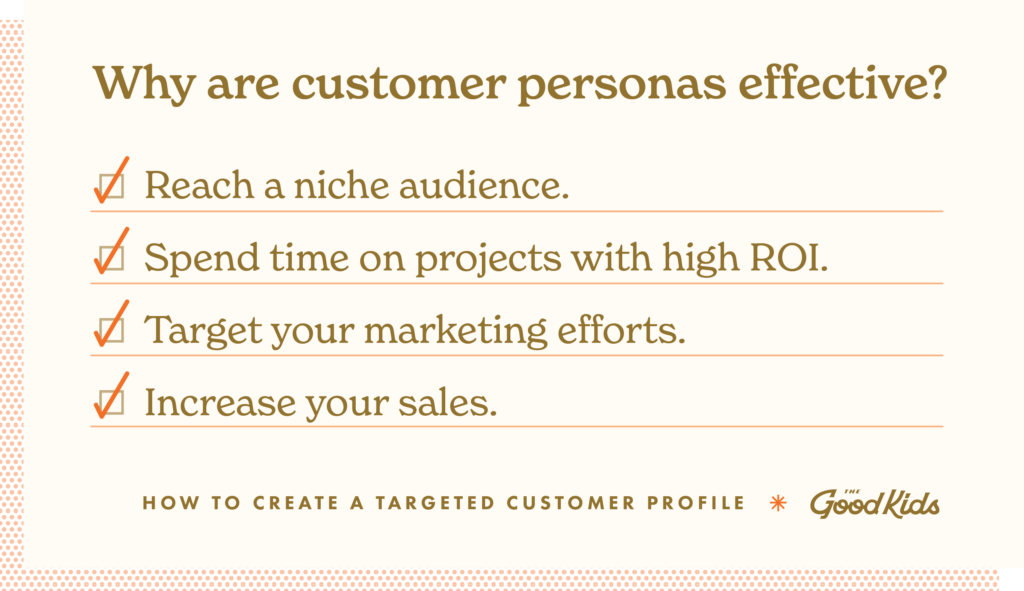
All in all, customer personas are a really effective tool for growing your business and increasing your sales. It’s a win-win because it targets your efforts towards helping your ideal customer while giving you a great return on your time and energy.
How To Define Your Target Persona
This is where the fun begins! It’s time to take a closer look at who your ideal customer is so you can create 1-3 targeted customer personas to guide your business decisions.
STEP 1: LEARN ABOUT YOUR CUSTOMER
Learn everything you can about your customer. The more information you have, the merrier. Whether you’re a new business or you’ve been at it for decades, you have more information than you probably realize. And if you don’t, it’s time to start collecting!
Here are some ways you can learn more:
- Customer Data – Review some of your best customers that are purchasing your product or service.
- Customer Surveys – Send out a simple survey to collect information about your audience. (Make sure to include an incentive to gather more results!)
- Google Analytics – Review your website data to see the demographics behind who’s making a purchase.
- Testimonials – Read through all the reviews and testimonials you’ve received in-person, on social media, or on your shop.
STEP 2: ANALYZE THEIR LIFESTYLE
Now that you have a ton of information on your ideal customer, it’s time to get a holistic view of their day-to-day life so that you can genuinely help them in their journey.
Here are some questions to guide your analysis:
- What’s their name?
- How old are they?
- What’s their gender?
- Where do they live?
- What’s their relationship status?
- Do they have a family?
- Education?
- Job title?
- Salary?
- Favorite interests?
- What types of clothes do they wear?
- Favorite drink?
- Favorite podcast?
- Preferred news source?
- Favorite genre of music?
- Ideal vacation?
- Favorite social network?
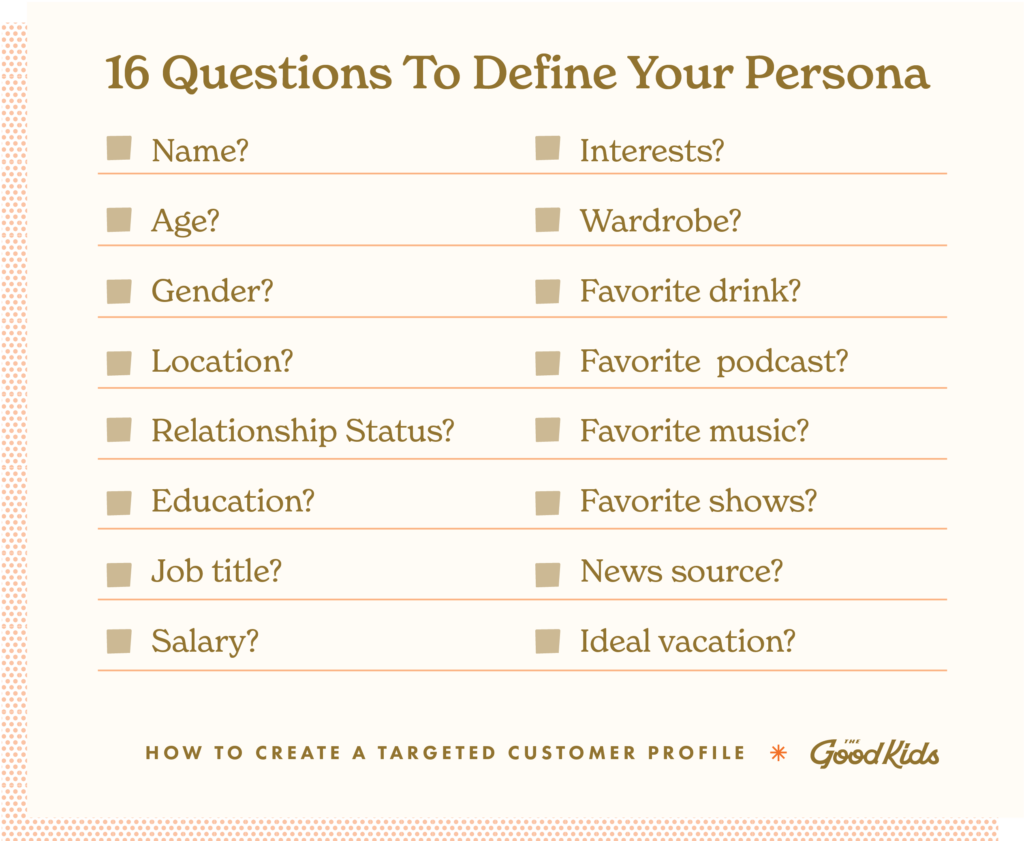
STEP 3: DISCOVER THEIR INNER SELF
Once you’ve have a high-level viewpoint of who your ideal customer is, it’s time to go a little deeper to learn about their motivations, desires, and pain points so you can appeal to what they need.
Here are some questions to dig deeper:
- What are their top goals in life?
- What’s their deepest desire?
- Who is their source of approval?
- Who’s their hero?
- Who are their enemies?
- What are their fears?
- What’s their biggest daily headache?
- What’s keeping them from seeing results?
- What are the consequences of letting the problem persist?
STEP 4: IDENTIFY THE BUYING TRIGGER
Knowing what you’ve just learned, take a step back and ask yourself, “What thought or pain point first leads your ideal customer to seek out your product or service?” Speaking to this exact thought or problem will allow you to help them like never before.
STEP 5: UNDERSTAND THEIR BUYING PROCESS
Now that your customer’s buying trigger has been activated, it’s essential to think through what they are considering when making their purchase so nothing gets between you and the sale.
Here are some questions to consider:
- What’s their budget?
- How do they find you?
- Where do they like to shop?
- What would make them hesitant to buy?
- Are they the only decision-maker or are others involved?
STEP 6: CREATE AN IDEAL CUSTOMER PROFILE
Using all of the information above, summarize some of the key details into a single-page profile so you can quickly and easily refer to this person whenever making business decisions.
To help you out, we’ve created a FREE template that you can download below! Fill this out and hang it up somewhere you will see often.
How To Implement Your Customer Persona
Ready to see the magic of using a target persona? Now that you know exactly who you are speaking to, you can target all of your efforts from your messaging to your sales calls.
HERE’S 4 WAYS TO START USING YOUR CUSTOMER PERSONA:
- Share them with your team. The best place to start is by communicating everything you’ve learned to your team so that they can carry your vision and prioritize their work based on the new persona(s). If you can hold an in-person meeting to do so, you can more easily bring the persona to life and express the importance of reasons behind why they are your target customer.
- Use messaging that speaks directly to them. Review your current brand messaging and visuals to pivot wherever need be so you can use the exact language that your target customer will gravitate towards. Now you can really focus in and perfect those talking points to quickly explain how your offering solves their problem. (More on this in a future blog.)
- Invest in specific marketing efforts. Now that you know the day-to-day of your target customer, you can invest your ad dollars into the specific spaces they hang out in (no more guessing)! To help you narrow in on what marketing efforts might suite you best, here’s some further questions to consider:
- Where are they spending time online? LinkedIn? Facebook? Quora?
- What types of content are they most interested in?
- Are they at their desk or on the go?
- Do they read blog posts? Watch videos? Listen to podcasts?
- Where do they go to get their information?
- Improve your sales calls. Using your new customer persona, you can perfect your sales calls to better identify who’s the right kind of lead, who to avoid, and how to speak to them once they hop on a call. Now you can capture their attention better and speak directly to their specific needs.
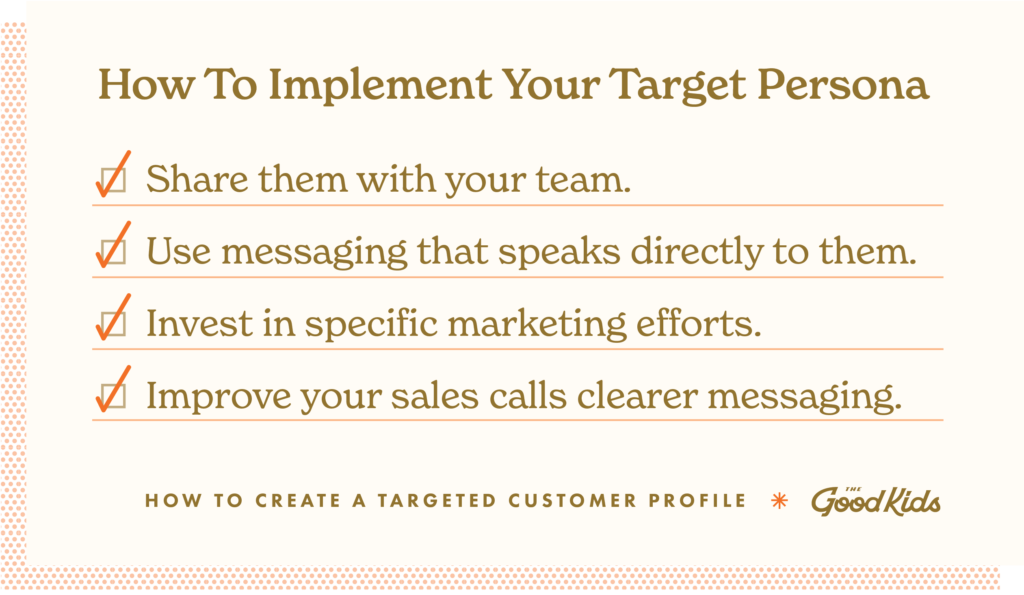
Now you’re all set!
Ready to dive deep and learn about your target audience? We’ve created a FREE worksheet to help you create a profile of your ideal audience. Once its complete, share this with your team and hang it up by your desk for daily reminders.
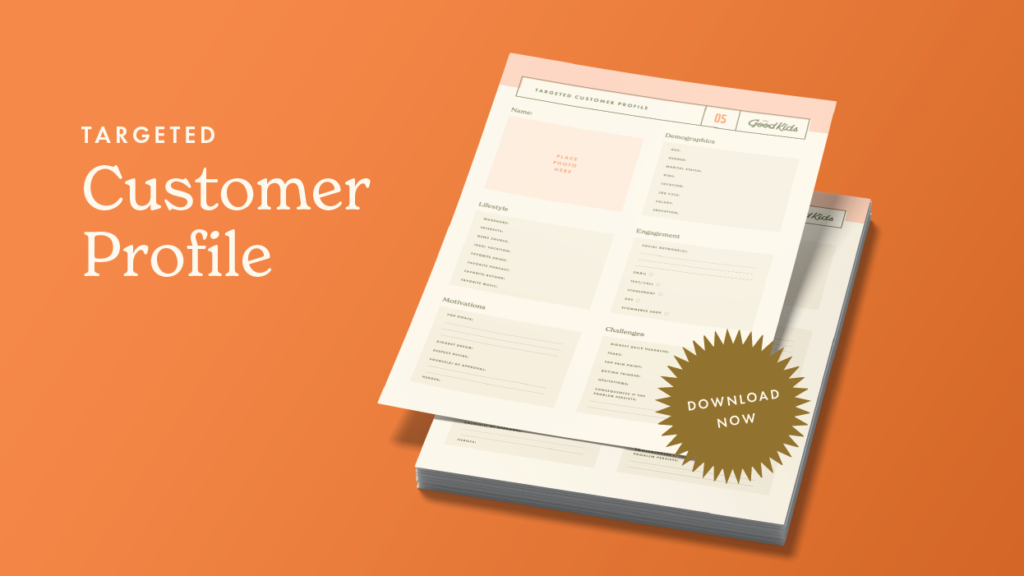
Stay tuned for more helpful resources in coming weeks. Next up, we’re going to share the 12 branding archetypes so you can discover what type of guide you can be to serve your audience best.
See ya then!


